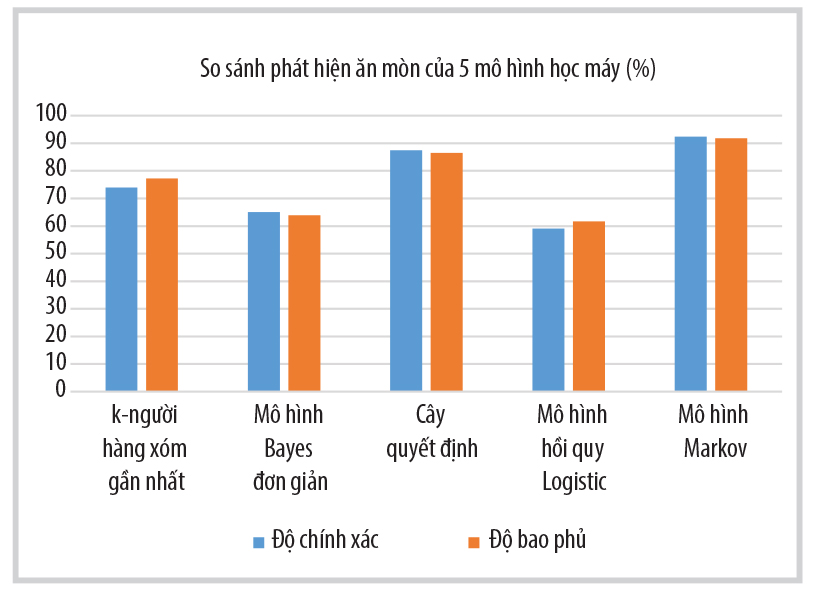Tự động phát hiện ăn mòn trên bề mặt đường ống dẫn khí sử dụng trí tuệ nhân tạo
Tóm tắt
Bài báo trình bày phương pháp phát hiện ăn mòn đường ống dẫn khí bằng cách sử dụng trí tuệ nhân tạo để phân tích các hình ảnh trực quan, gồm 3 bước: tiền xử lý ảnh đầu vào; phân đoạn và trích chọn các đặc trưng biểu đồ tần suất màu và đặc trưng kết cấu; đề xuất sử dụng mô hình Markov ẩn được huấn luyện từ các vector đặc trưng có khả năng tự động phân tích các hình ảnh chụp từ camera và nhận dạng các vùng bị ăn mòn của đường ống dẫn khí. Thử nghiệm ban đầu trên tập dữ liệu hơn 5.000 ảnh chụp các đường ống dẫn khí cho thấy phương pháp đề xuất cho kết quả chính xác trên 90%.
Các tài liệu tham khảo
Gerhardus Koch, Jeff Varney, Neil Thopson, Oliver Moghissi, Melissa Goud, and Joe Payer, “International measures of prevention, application, and economics of corrosion technologies study”, NACE International, 2016.
Duzgun Agdas, Jennifer A. Rice, Justin R. Martinez, and Ivan R. Lasa, "Comparison of visual inspection and structural-health monitoring as bridge condition assessment methods", Journal of Performance of Constructed Facilities, Vol. 30, No. 3, pp. 1 - 10, 2016. DOI: 10.1061/(ASCE)CF.1943-5509.0000802.
Marat Enikeev, Irek Gubaydullin, and Marina Maleeva, “Analysis of corrosion process development on metals by means of computer vision”, Engineering Journal, Vol. 21, No. 4, pp. 183 - 192, 2017. DOI: 10.4186/ ej.2017.21.4.183.
Flávio Felix Feliciano, Fabiana Rodrigues Leta, and Fernando Benedicto Mainier, “Texture digital analysis for corrosion monitoring”, Corrosion Science, Vol. 93, pp. 138 - 147, 2015. DOI: 10.1016/j.corsci.2015.01.017.
Po-Han Chen, Ya-Ching Yang, and Luh-Maan Chang, “Automated bridge coating defect recognition using adaptive ellipse approach”, Automation in Construction, Vol. 18, No. 5, pp. 632 - 643, 2009. DOI: 10.1016/j.autcon.2008.12.007.
Amjad Khan, Syed Saad Azhar Ali, Atif Anwer, Syed Hasan Adil, and Fabrice Mériaudeau, “Subsea pipeline corrosion estimation by restoring and enhancing degraded underwater images”, IEEE Access, Vol. 6, pp. 40585 - 40601, 2018. DOI: 10.1109/ACCESS.2018.2855725.
M. Khayatazad, L. De Pue, and W. De Waele, “Detection of corrosion on steel structures using automated image processing”, Developments in the Built Environment, Vol. 3, 2020. DOI: 10.1016/j.dibe.2020.100022.
Luca Petricca, Tomas Moss, Gonzalo Figueroa, and Stian Broen. “Corrosion detection using A.I: A comparison of standard computer vision techniques and deep learning model”, The 6th International Conference on Computer Science, Engineering and Information Technology, Vienna, Austria, 21 - 22 May 2016. DOI: 10.5121/csit.2016.60608.
Tom Gibbons, Gareth Pierce, Keith Worden, and Ifigeneia Antoniadou, "A Gaussian mixture model for automated corrosion detection in remanufacturing", 16th International Conference on Manufacturing Research ICMR, 11 - 13 September 2018. DOI: 10.3233/978-1-61499-902-7- 63.
Francisco Bonnin-Pascuala and Alberto Ortiz, “Corrosion detection for automated visual inspection”, Developments in Corrosion Protection. InTech, 2014, pp. 619 - 632. DOI: 10.5772/57209.
Kristie Seymore, Andrew McCallum, and Ronald Rosenfeld, “Learning hidden Markov model structure for information extraction”, AAAI Technical Report WS-99-11, pp. 37 - 42, 1999.
Yasuo Matsuyama, "Hidden Markov model estimation based on alpha-EM algorithm: Discrete and continuous alpha-HMMs", International Joint Conference on Neural Networks, USA, 31 July - 5 August 2011. DOI: 10.1109/IJCNN.2011.6033304.
Blossom Treesa Bastian, N. Jaspreeth, S. KumarRanjithb, and C.V. Jiji, "Visual inspection and characterization of external corrosion in pipelines using deep neural network", NTD & E International, No. 107, pp. 102 - 134, 2019. DOI: 10.1016/j.ndteint.2019.102134.
G. McLachlan and T. Krishnan, The EM algorithm and extensions, 2nd edition. John Wiley & Sons, 2008.

1. Tác giả giao bản quyền bài viết (tác phẩm) cho Tạp chí Dầu khí, bao gồm quyền xuất bản, tái bản, bán và phân phối toàn bộ hoặc một phần tác phẩm trong các ấn bản điện tử và in của Tạp chí Dầu khí.
2. Bằng cách chuyển nhượng bản quyền này cho Tạp chí Dầu khí, việc sao chép, đăng hoặc sử dụng một phần hay toàn bộ tác phẩm nào của Tạp chí Dầu khí trên bất kỳ phương tiện nào phải trích dẫn đầy đủ, phù hợp về hình thức và nội dung như sau: tiêu đề của bài viết, tên tác giả, tên tạp chí, tập, số, năm, chủ sở hữu bản quyền theo quy định, số DOI. Liên kết đến bài viết cuối cùng được công bố trên trang web của Tạp chí Dầu khí được khuyến khích.




